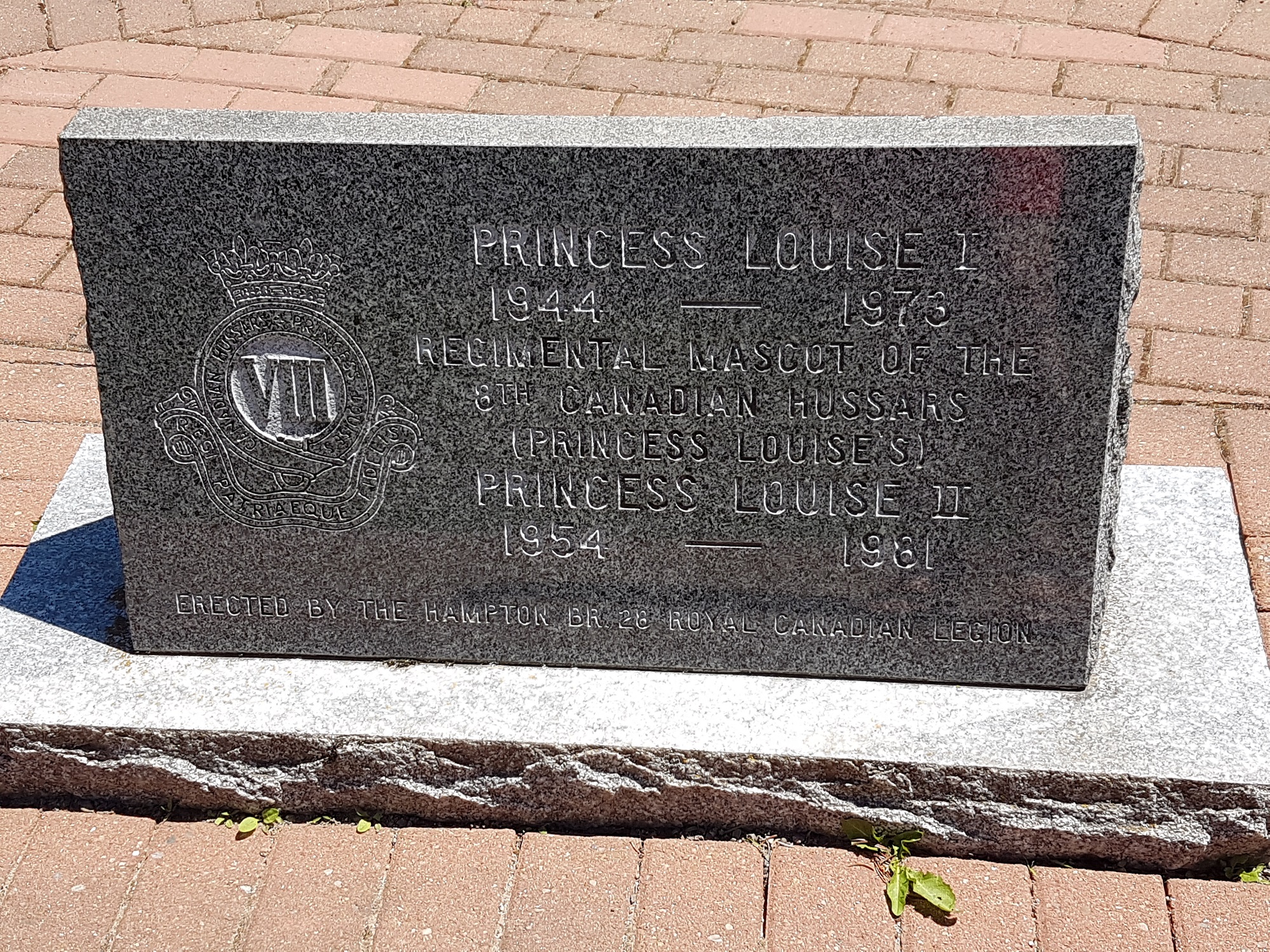PRINCESS LOUISE I
1944 - 1973
REGIMENTAL MASCOT OF THE
8TH CANADIAN HUSSERS
(PRINCESS LOUISE'S)
PRINCESS LOUISE II
1954 - 1981
ERECTED BY THE HAMPTON BR. 28 ROYAL CANADIAN LEGION
[plaque]
Story of Princess Louise Mascot
This is a true story of the life and times of a filly born in Italy in 1944 that became the Regimental Mascot of the 8th Princess. Louise's New Brunswick Hussars' re-designated in 1957 as the 8th Canadian Hussars (Princess Louise's). This is HER story.
In the spring of 1944 I was born in a peaceful pasture in Italy near the town of Coriano which was a battle line heavily defended by elite German soldiers. The peaceful atmosphere was soon shattered by sounds of gunfire and shelling from the south growing continually closer each day. Early in September the guns and the German soldiers passed through my pasture. Explosions erupted around me. My mother was killed and I was wounded.
The Germans were followed by more soldiers, guns and Sherman tanks. These soldiers were dressed in khaki. They wore flashy shoulder badges showing they were Canadians of the 8th Princess Louise's New Brunswick Hussars which in 1848 had been a cavalry regiment but were now part of the 5th Canadian Armoured Division. Most of the tanks moved on chasing the Germans but some stayed. They were disabled.
On the night of September 15th 1944 with shells still exploding all around, more 8th Hussar soldiers came to repair disabled tanks. I was lonely , thirsty and hungry. My mother had been dead several days. As I was trotting around her body in a well-worn path another shell exploded and I screamed in pain as I was hit by another piece of shrapnel.
When the shelling eased up the 8th Hussar soldiers took me in the back of their truck directly to their medical officer. He first protested that he wasn't a veterinarian but then speedily, tenderly and expertly dressed my wounds after the customary rum ration. This demonstrated that the original cavalry instincts and the love of horses were still predominant in the Regiment.
It just seemed automatic that I became known as Princess Louise, the Mascot of the regiment and I was delighted with my royal title. My liberators, all ranks of the 8th Hussars, were my guardians and considered me a moral booster. They had been overseas for almost four years and had been in action in Italy for almost one year. I was a pleasant distraction as we chased the Germans north.
We occasionally had rest periods and held Regimental parades. I always marched smartly at the head of the parade and gaily tossed my head in the air to acknowledge the salutes I received from the soldiers with red tabs and gold braid on the saluting base.
I had to be smuggled out of Italy when the Hussars were moved by ship from Leghorn to France but I stayed with them continually in North West Europe until the German Army surrendered in May 1945. I received royal treatment while in Holland but when the 8th Hussars sailed for Canada on a troop ship early in 1946 I could not accompany them. Arrangements were made for me to be cared for and in March 1946 I was shipped to New York and traveled to Saint John by train. There I received a royal welcome. There was a Guard of Honour and an 8th Hussar Parade on March 27th 1946. I was welcomed by municipal and military authorities as I proudly displayed my 8th Hussar Badges and flashes, 5th Canadian Armoured Division Maroon Pateh. Campaign medals (1939-45 star, Italy Star, France-Germany Star, Canadian Voluntary Service Medal. Victory Medal and 3 Wound Stripes).
The tumultuous welcome I received from the Rothesay students who were allowed out of school to greet me, the formal ceremony on the steps of the Kings County Court House where I became a naturalized Canadian Citizen, a free woman of Kings County and Community of Hampton, and a member of Hampton Branch #28 of the Royal Canadian Legion, completed my official welcome.
It was here I met Captain Thad Stevens who stabled me on his property and I recognized an excellent horseman. It was a case of love at first sight and mutual respect ensued. By this time I had completed a journey of about 16,000 miles since becoming the Regimental Mascot.
I frequently traveled to Sussex where the Hussars were not a very active militia unit. I attended Regimental Parades, Armistice Day Parades in numerous localities as well as special parades and events in Fredericton, St. Stephen, Calais, Maine, Truro, Halifax, Centennial celebrations on the 21st of June 1949 Military summer camps and many special occasions where I renewed old acquaintances with Field Marshall Montgomery, Field Marshal Alexander (now Governor General of Canada), Duchess of Kent, Princess Alexandra, Princess Margaret, Colonel in chief of the Regiment Princess Anne, Governor General Vincent Massey, Honourable Colonel R. W. Moncel, Mr. A. H. J. Lovink Dutch Ambassador to Canada who presented the Hussars with a Gold Medal of Honour in appreciation of their services during liberation of Holland. I also associated several times with the famous Canadian Warrior, General Fighting Frank Worthington, the father of the Royal Canadian Armoured Corps.
In 1954 I was blessed with a daughter, Princess Louise II, who became the mascot for the 8th Canadian Hussars (Princess Louise's) when they were added to the Regular Force in 1957. My only grandchild, Princess Louise III died shortly after birth in 1969.
Although I passed away in 1973 and was followed by Princess Louise II in 1981, we are both buried in Veterans Park in Hampton where this plaque is displayed. Nevertheless our spirits continue to guide the 8th Hussars in maintaining their motto: Regi Patriaeque Fidelis-Faithful to Sovereign and Country
[framed horseshoes]
THE LAST PAIR OF SHOES WORN BY PRINCESS LOUISE
BATTLE MASCOT OF THE 8TH PRINCESS LOUISES HUSSARS





